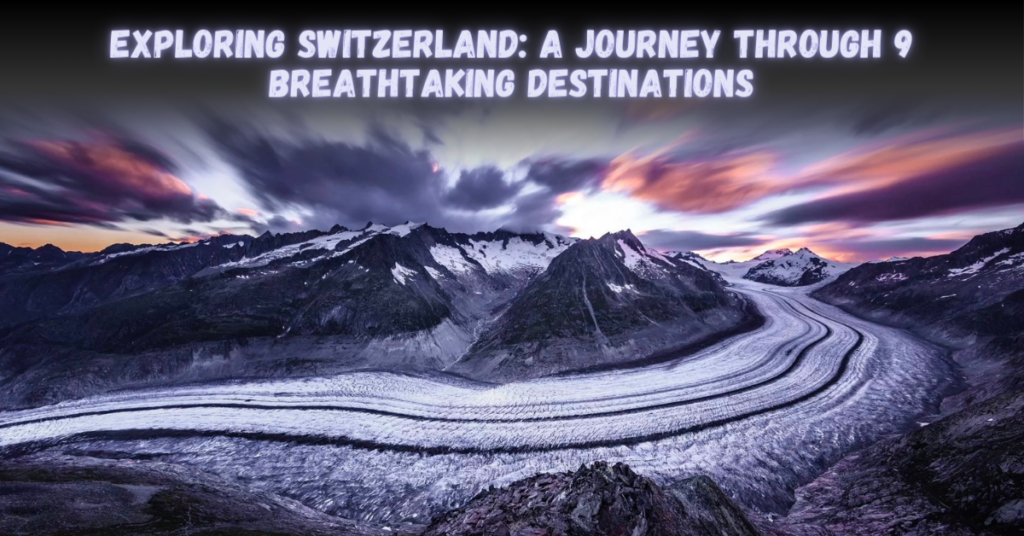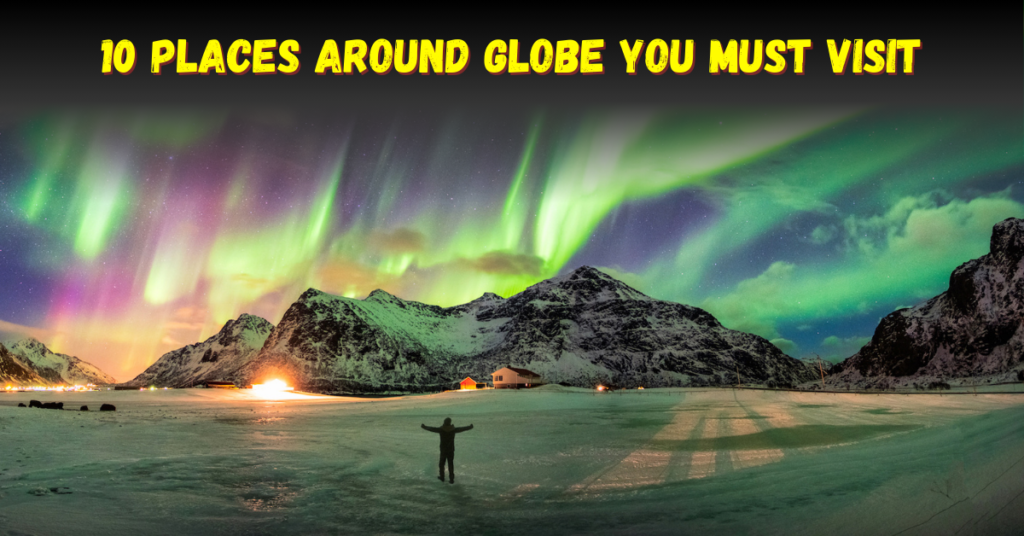Our planet boasts a staggering diversity of landscapes, each offering a unique tapestry of natural wonders. From towering mountains that pierce the clouds to vibrant coral reefs teeming with life, Discover Top 6 The Best Landscape Place in The World, which ignite our sense of wonder and inspire a deep appreciation for the Earth’s beauty.
Whether you’re a seasoned adventurer or an armchair traveller, this list Discover Top 6 The Best Landscape Place in The World guaranteed to leave you spellbound.
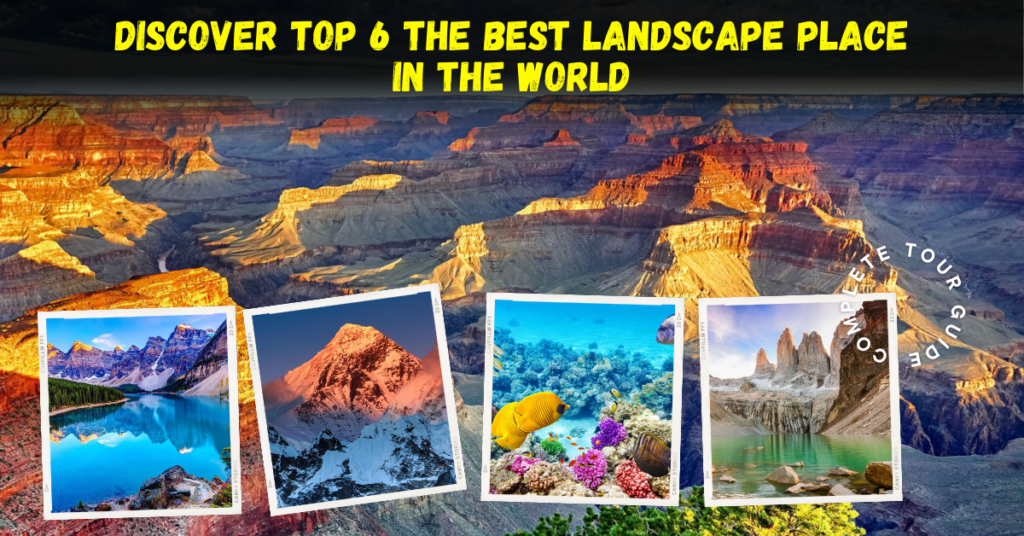
1. The Grand Canyon, USA: A Timeless Testament to Geologic Forces
The Grand Canyon, carved by the relentless Colorado River over millions of years, stands as a majestic symbol of the Earth’s enduring power. Its layered bands of colorful rock chronicle eons of geologic history, stretching for a staggering 277 miles (446 km) with depths reaching over a mile (1.6 km).

Visitors can explore the canyon’s vastness from various vantage points. Hike along the rim trails for panoramic vistas, delve deeper into the canyon on day hikes, or embark on multi-day backpacking adventures for a truly immersive experience. Helicopter tours offer a bird’s-eye view of the immense scale, while whitewater rafting on the Colorado River provides a thrilling perspective from below.
The Grand Canyon (Discover Top 6 The Best Landscape Place in The World) isn’t just a scenic marvel; it’s a haven for diverse flora and fauna. Juniper and pine forests cling to the canyon walls, while bighorn sheep and condors soar through the vast expanse. Stargazing from the canyon rim reveals a breathtaking display of celestial bodies due to minimal light pollution.
Planning Your Grand Canyon Adventure
- Itinerary:
- Day 1: Arrive at the South Rim Visitor Center, explore Mather Point and Yavapai Point for panoramic views. Hike the South Kaibab Trail for stunning canyon vistas.
- Day 2: Descend into the canyon on a guided day hike or mule ride. Explore the geology and unique ecosystems on the canyon floor.
- Day 3: Visit the Desert View Watchtower for breathtaking views of the eastern canyon rim. Hike rim trails like Grandview Trail or Trail of Time for diverse perspectives.
- Cost: Entrance fees vary depending on entry method (vehicle, foot, etc.) and range from $30-$80. Budget for accommodation, meals, and activities like guided tours or helicopter rides.
- Best Time to Visit: Spring (March-May) and fall (September-November) offer pleasant temperatures for hiking. Winter (December-February) showcases the canyon dusted in snow, but some facilities and trails may be closed.
- Visa and Documentation: For stays less than 90 days, most nationalities don’t require a visa but a valid passport is mandatory. Check current visa requirements with the U.S. Department of State.
Cultural Significance
The Grand Canyon (Discover Top 6 The Best Landscape Place in The World) holds deep significance for many Native American tribes who have inhabited the region for millennia. The Havasupai Tribe still resides within the canyon, and their culture is centered around respecting the delicate balance of the natural world.
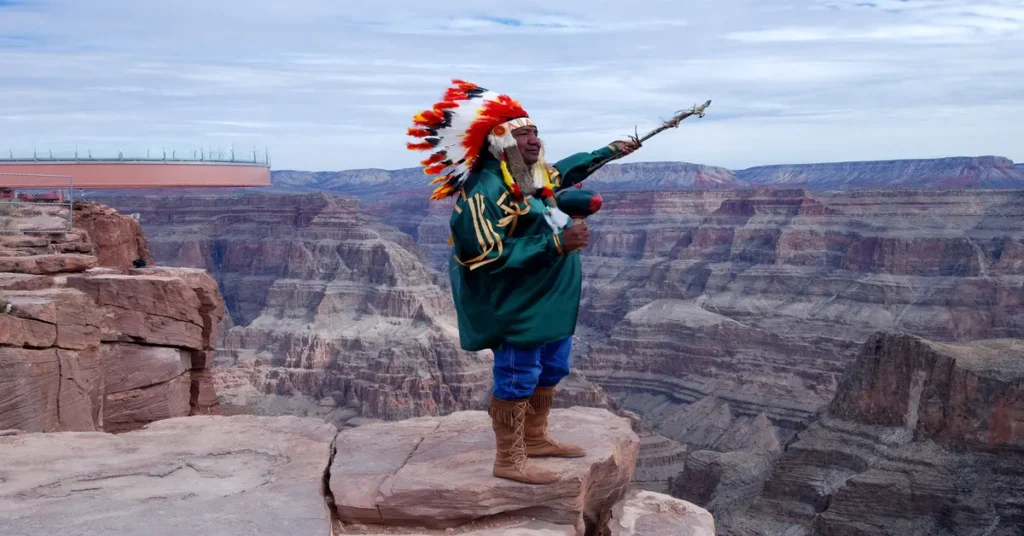
Food Culture
Around the Grand Canyon National Park (Discover Top 6 The Best Landscape Place in The World), you’ll find a variety of dining options, from casual cafes to fine dining establishments. For a true taste of the Southwest, try dishes like Navajo frybread, blue corn enchiladas, or cactus fries.
2. Banff National Park, Canada: A Canadian Rocky Mountain Paradise
Nestled in the majestic Canadian Rockies, Banff National Park is a wonderland of emerald lakes, towering snow-capped peaks, and abundant wildlife. Lake Louise, with its turquoise waters reflecting the Victoria Glacier, is a postcard-perfect scene. Moraine Lake, another glacial gem, shimmers with an almost unreal turquoise hue.

Visitors can immerse themselves in Banff’s natural splendor by hiking or biking along scenic trails, taking a gondola ride up Sulphur Mountain for stunning panoramic views, or canoeing on the serene lakes. Spotting wildlife like elk, grizzly bears, and bighorn sheep is a common occurrence. During winter, the park transforms into a skier’s paradise with world-class slopes and breathtaking scenery.
The charming town of Banff (Discover Top 6 The Best Landscape Place in The World), nestled within the park, offers excellent accommodations, restaurants, and shops, making it a great base for exploring the region.
Exploring Banff’s Natural Splendor
- Itinerary:
- Day 1: Hike or bike the scenic Johnston Canyon Loop for stunning waterfalls and limestone formations. Take a gondola ride up Sulphur Mountain for panoramic views of the park.
- Day 2: Canoe on the serene waters of Lake Louise, surrounded by towering mountains. Explore Moraine Lake and capture its iconic turquoise beauty.
- Day 3: Hike the challenging but rewarding Lake Agnes Trail for breathtaking vistas of the surrounding peaks. Visit the charming town of Banff, offering shops, restaurants, and cultural experiences.
- Cost: Park admission fees apply (around $20 per day) for vehicles. Budget for accommodation, meals, and activities like gondola rides, canoe rentals, or guided hikes.
- Best Time to Visit: Summer (June-August) offers warm weather ideal for hiking and outdoor activities. Winter (December-March) transforms the park into a skier’s paradise. Shoulder seasons (spring and fall) provide pleasant temperatures with fewer crowds.
- Visa and Documentation: Most nationalities require a valid passport and Electronic Travel Authorization (eTA) for entering Canada.
Cultural Significance
The Banff National Park (Discover Top 6 The Best Landscape Place in The World) area has been inhabited by indigenous peoples for thousands of years. The Stoney Nakoda First Nation (formerly known as the Assiniboine) are the traditional stewards of the land. Their culture is deeply intertwined with the natural world, and they believe in respecting the delicate balance of the ecosystem. Parks Canada works collaboratively with the Stoney Nakoda to ensure the park’s cultural and natural heritage is preserved.

Food Culture
The town of Banff (Discover Top 6 The Best Landscape Place in The World) offers a variety of dining options, from casual pubs serving Canadian classics like poutine (french fries with gravy and cheese curds) to upscale restaurants with innovative takes on regional cuisine. Sample local specialties like Alberta beef, fresh Rocky Mountain trout, and wild huckleberries.
See More: Discovering Ireland: 7 Enchanting Destinations to Explore
3. The Great Barrier Reef, Australia: A Vibrant Underwater Tapestry
The Great Barrier Reef, the world’s largest coral reef system, is a breathtaking underwater masterpiece. Stretching over 2,300 kilometers (1,400 miles) along Australia’s east coast, it’s the only living structure visible from space.

This vibrant ecosystem teems with an incredible diversity of marine life. Colorful coral reefs house over 1,500 species of fish, 411 types of hard coral, and countless other marine creatures. Snorkeling or diving the Great Barrier Reef (Discover Top 6 The Best Landscape Place in The World) is an unforgettable experience, allowing you to witness this underwater wonderland firsthand.
Sadly, the Great Barrier Reef faces significant threats due to climate change, pollution, and overfishing. Conservation efforts are underway to protect this vital ecosystem, but responsible tourism is crucial. Choose eco-friendly tours that prioritize the reef’s health, and avoid activities that may damage the coral.
Witnessing the Underwater Wonderland
- Itinerary:
- Day 1: Choose from various day trips or liveaboard expeditions departing from Cairns, Port Douglas, or Whitsunday Islands. Snorkel or dive the vibrant coral reefs, encountering diverse marine life.
- Day 2: Explore a different section of the reef, participating in activities like coral reef talks, underwater photography workshops, or helicopter tours for a unique perspective.
- Day 3: Relax on pristine beaches, explore nearby islands, or visit the Daintree Rainforest, the oldest rainforest on Earth.
- Cost: Day trips and liveaboard expeditions vary in cost depending on duration, location, and inclusions. Budget for accommodation, meals, and potential diving certifications or equipment rentals.
- Best Time to Visit: The dry season (May-October) offers calm seas and good visibility for diving and snorkeling. Avoid the wet season (November-April) due to potential cyclones and stinger jellyfish.
- Visa and Documentation: Most nationalities require a visa to enter Australia. Apply for the appropriate visa type well in advance of your trip. Check current visa requirements with the Australian Department of Home Affairs.
Cultural Significance
The Great Barrier Reef (Discover Top 6 The Best Landscape Place in The World) holds cultural significance for the Aboriginal and Torres Strait Islander peoples who have inhabited the region for millennia. Their stories and traditions are deeply connected to the reef, and they have a profound understanding of its delicate ecosystem.

Food Culture
Queensland, where the Great Barrier Reef (Discover Top 6 The Best Landscape Place in The World) is located, offers a delicious fusion of fresh seafood, tropical fruits, and international influences. Sample dishes like Moreton Bay bug (a giant local prawn), coral trout cooked in various styles, and tropical fruit smoothies.
4. Patagonia, Argentina and Chile: A Land of Untamed Beauty
Patagonia, a vast region at the southern tip of South America shared by Argentina and Chile, is a land of dramatic landscapes and untamed wilderness. Towering mountains like Fitz Roy pierce the sky, vast glaciers carve their way through the rugged terrain, and crystal-clear lakes reflect the grandeur of the surroundings.
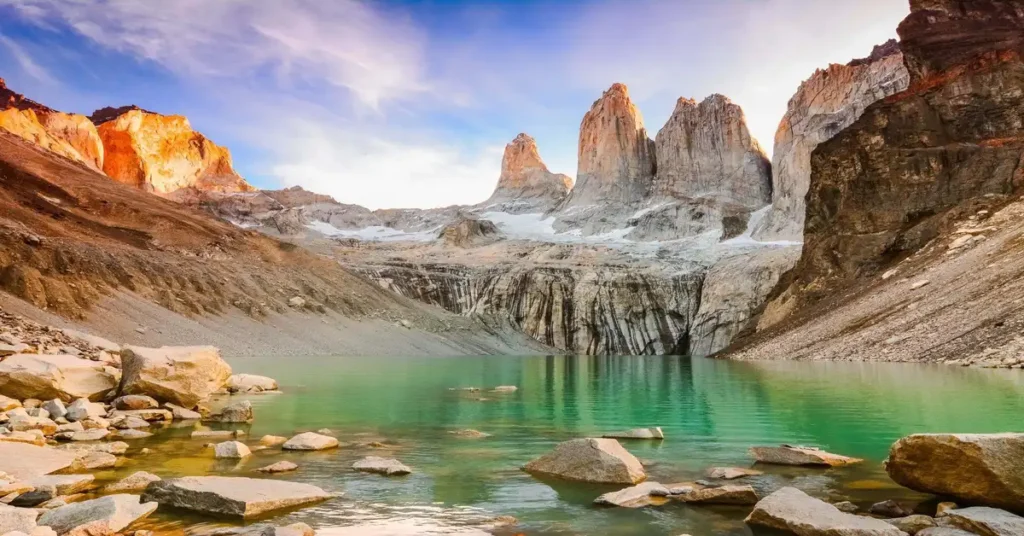
Patagonia (Discover Top 6 The Best Landscape Place in The World) caters to adventurous travelers seeking a connection with nature. Hike through Torres del Paine National Park, known for its granite peaks, turquoise lakes, and glaciers. Kayak through the Beagle Channel, where you might encounter penguins and whales. Embark on a wildlife safari in Tierra del Fuego National Park, spotting guanacos, foxes, and various bird species.
For those seeking a cultural experience, Patagonia offers charming towns like El Calafate and Ushuaia, known as the “End of the World.”
Embarking on a Patagonian Adventure
- Itinerary:
- Day 1: Arrive in El Calafate, Argentina, the gateway to Los Glaciares National Park. Explore Perito Moreno Glacier, a UNESCO World Heritage Site, and witness its awe-inspiring calving formations.
- Day 2: Hike through Torres del Paine National Park in Chile, known for its granite peaks, turquoise lakes, and diverse wildlife. Spot guanacos, condors, and flamingos.
- Day 3: Kayak through the Beagle Channel, where you might encounter penguins and whales. Explore Ushuaia, Argentina, nicknamed “The End of the World,” and soak in the unique atmosphere.
- Cost: Costs vary depending on chosen activities, transportation, and accommodation. Budget for park entrance fees, guided tours, kayaking excursions, and flights between Argentina and Chile.
- Best Time to Visit: Summer (December-February) offers the warmest weather for hiking and exploring. However, expect crowds. Shoulder seasons (spring and fall) provide pleasant temperatures with fewer crowds. Winter (June-August) offers opportunities for winter sports and unique landscapes, but some facilities and trails may be closed.
- Visa and Documentation: Visa requirements depend on your nationality and the duration of your stay. Check current visa requirements with Argentinian and Chilean immigration authorities.
Cultural Significance
Patagonia (Discover Top 6 The Best Landscape Place in The World) is home to the indigenous Mapuche people, known for their horsemanship skills and strong cultural identity. Their traditions are deeply connected to the Patagonian landscape, and they believe in living in harmony with nature.

Food Culture
Patagonia (Discover Top 6 The Best Landscape Place in The World) offers a hearty cuisine influenced by Argentinian and Chilean traditions. Sample delicious dishes like Patagonian lamb (known for its tenderness due to the sheep grazing on wild herbs), fresh seafood like centolla (giant spider crab), and empanadas filled with various savory fillings. Don’t miss trying local beverages like Patagonia craft beer and Malbec wine from Mendoza.
See More: 7 Best Beaches in Greece With the Bluest Water You’ve Ever Seen
5. Mount Everest, Nepal and Tibet: The Roof of the World
Mount Everest, the Earth’s highest mountain, is a legendary peak that has captivated explorers for centuries. Towering at a staggering 8,848 meters (29,032 feet), it stands as a formidable challenge and a symbol of human perseverance. While reaching the summit requires a dangerous expedition, the beauty of the surrounding Himalayas is undeniable.

For most travelers, witnessing Everest’s (Discover Top 6 The Best Landscape Place in The World) grandeur is a dream come true. Trekking to Everest Base Camp offers breathtaking views of the mountain and surrounding peaks, along with the opportunity to experience the unique culture of the Khumbu Valley. The trek, while challenging, is an achievable way to get close to this legendary mountain. Helicopter tours provide a thrilling aerial perspective of Everest and the Himalayas, showcasing the vastness and scale of this incredible mountain range.
Experiencing the Majesty of Everest
- Itinerary:
- Day 1: Arrive in Kathmandu, Nepal, and acclimatize to the altitude. Explore the vibrant city and its rich cultural heritage.
- Day 2: Embark on the trek to Everest Base Camp, passing through traditional Sherpa villages and experiencing breathtaking mountain scenery.
- Day 8 (after acclimatization days): Reach Everest Base Camp, standing at 5,364 meters (17,598 feet) and witnessing the awe-inspiring presence of Mount Everest.
- Day 12-14: Descend back to lower altitudes, enjoying the diverse landscapes and cultural encounters along the way.
- Cost: Trekking to Everest Base Camp can be expensive. Budget for trekking permits, park entrance fees, guide services, porters, and accommodation in teahouses. Costs can range from $3,000 to $10,000 depending on the chosen itinerary and operator.
- Best Time to Visit: Spring (March-May) offers clear skies and pleasant temperatures for trekking. However, expect crowds on the trails. Fall (September-November) is another good option with fewer crowds and comfortable temperatures. Avoid the monsoon season (June-August) due to heavy rain and potential landslides.
- Visa and Documentation: A visa is required to enter Nepal. Apply for the appropriate visa type well in advance of your trip. Check current visa requirements with Nepalese immigration authorities. Permits are also required for trekking in specific regions, including Everest Base Camp.
Cultural Significance
Mount Everest (Discover Top 6 The Best Landscape Place in The World) holds immense significance for the Sherpa people who inhabit the Khumbu Valley. Their way of life is deeply intertwined with the mountain, and they possess exceptional mountaineering skills honed over generations.

Food Culture
While trekking to Everest Base Camp, you’ll encounter typical Nepali cuisine. Dal bhat (lentil soup with steamed rice) is a staple, often accompanied by curries, vegetables, and pickles. Yak meat is a local delicacy you might encounter in higher villages. In Kathmandu, you’ll find a wider variety of Nepali dishes and international influences.
6. Fiordland National Park, New Zealand: A Realm of Enchanting Fjords
Fiordland National Park, a UNESCO World Heritage Site, encapsulates the dramatic beauty of New Zealand’s South Island. Jagged mountains pierce the sky, carved by glaciers into majestic fjords adorned with cascading waterfalls. Dense rainforests cloak the mountainsides, teeming with unique birdlife like the flightless Kakapo parrot.

Exploring Fiordland National Park (Discover Top 6 The Best Landscape Place in The World) is an adventure in itself. Kayak through the serene waters of Milford Sound, a spectacular fjord surrounded by towering cliffs. Hike the Milford Track, one of the world’s most famous trails, offering breathtaking views of glaciers, waterfalls, and native forests.
For an unforgettable experience, take a scenic flight over the fiords, providing a panoramic perspective of this awe-inspiring landscape.
Unveiling Fiordland’s Natural Wonders
- Itinerary:
- Day 1: Arrive in Te Anau, the gateway to Fiordland National Park. Explore the town and its surrounding lakes.
- Day 2: Take a scenic cruise through Milford Sound, a spectacular fjord surrounded by towering cliffs and cascading waterfalls. Witness wildlife like dolphins, seals, and Fiordland penguins.
- Day 3: Hike the Milford Track, one of the world’s most famous trails, offering breathtaking views of glaciers, waterfalls, and native forests. Alternatively, kayak through the serene waters of Doubtful Sound, a less-visited but equally stunning fjord.
- Day 4: Explore the glowworm caves near Te Anau, where thousands of glowworms illuminate the caverns in an ethereal display.
- Cost: Costs vary depending on chosen activities and accommodation. Budget for park entrance fees, scenic cruises, guided hikes or kayaking excursions, and accommodation in Te Anau or Milford Sound.
- Best Time to Visit: Summer (December-February) offers the warmest weather and longest daylight hours for exploring the fiords. However, expect higher tourist numbers. Shoulder seasons (spring and fall) provide pleasant temperatures with fewer crowds, but some facilities and trails might have limited hours. Winter (June-August) offers a unique perspective with fewer crowds, but some activities may not be available due to weather conditions.
- Visa and Documentation: Most nationalities require a valid passport and Electronic Travel Authority (ETA) to enter New Zealand. Check current visa requirements with New Zealand immigration services.
Cultural Significance
Fiordland National Park (Discover Top 6 The Best Landscape Place in The World) holds deep significance for Maori, the indigenous people of New Zealand. Their traditions and stories are interwoven with the landscape. They believe the Fiords were carved by the demigod Tu Te Waika a Roimata (Weeping Waters) and revere them for their natural beauty and spiritual power.

Food Culture
Te Anau offers a variety of dining options, from cafes serving fresh seafood and local produce to restaurants with international cuisine. Sample dishes like Fiordland crayfish, Southland lamb, and seafood chowder. Don’t forget to try a slice of pavlova, a classic New Zealand dessert made with meringue, whipped cream, and fresh fruit.
See More: Best Places to Visit in the USA for First Time Travelers
Conclusion: Discover Top 6 The Best Landscape Place in The World
These six landscapes on the list: Discover Top 6 The Best Landscape Place in The World; represent just a fraction of the Earth’s incredible diversity. From the vast scale of the Grand Canyon to the underwater wonders of the Great Barrier Reef, each destination offers a unique perspective on the power and beauty of nature.
So pack your bags, fuel your sense of adventure, and embark on a journey to Discover Top 6 The Best Landscape Place in The World for yourself. Remember, responsible tourism is crucial to preserve these natural wonders for generations to come. Choose eco-friendly options, minimize your impact, and leave only footprints.
Thanks for Visiting Us In Focus!
For DMCA complaints, please visit our DMCA Form / Report Content
Follow us on other platforms as follows:
Facebook – https://www.facebook.com/usinfocus
X (formerly Twitter) – https://twitter.com/usinfocusdotcom

